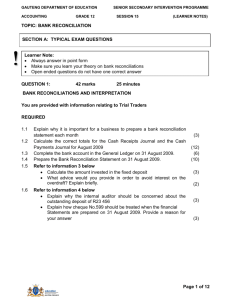Bank Reconciliations
advertisement
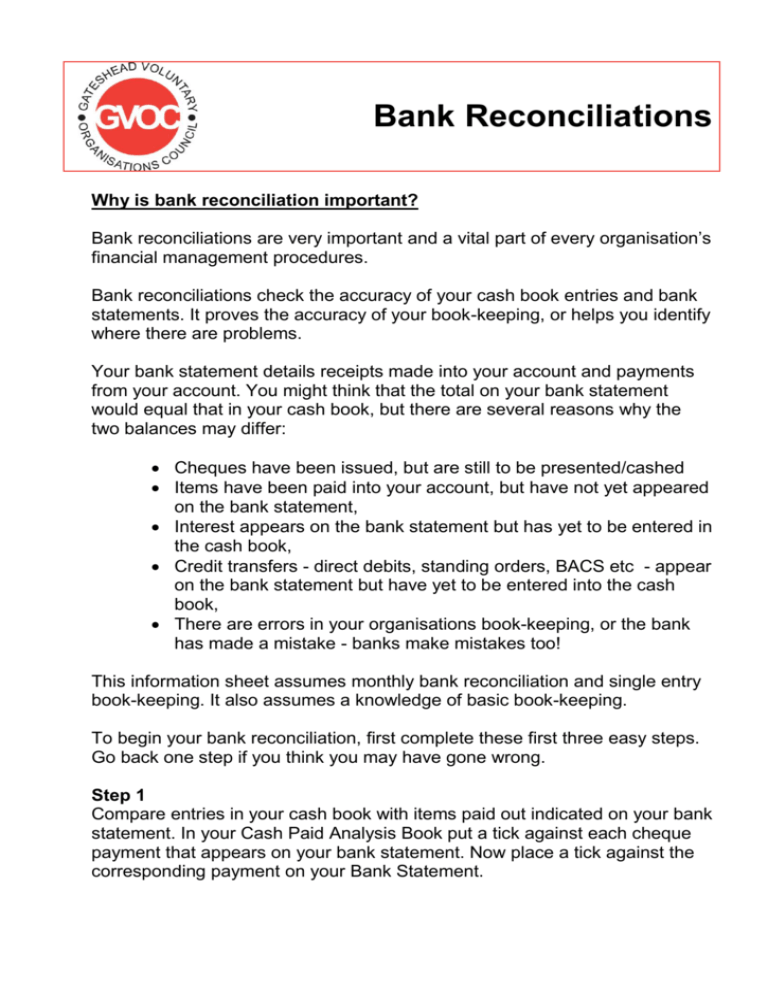
Bank Reconciliations Why is bank reconciliation important? Bank reconciliations are very important and a vital part of every organisation’s financial management procedures. Bank reconciliations check the accuracy of your cash book entries and bank statements. It proves the accuracy of your book-keeping, or helps you identify where there are problems. Your bank statement details receipts made into your account and payments from your account. You might think that the total on your bank statement would equal that in your cash book, but there are several reasons why the two balances may differ: Cheques have been issued, but are still to be presented/cashed Items have been paid into your account, but have not yet appeared on the bank statement, Interest appears on the bank statement but has yet to be entered in the cash book, Credit transfers - direct debits, standing orders, BACS etc - appear on the bank statement but have yet to be entered into the cash book, There are errors in your organisations book-keeping, or the bank has made a mistake - banks make mistakes too! This information sheet assumes monthly bank reconciliation and single entry book-keeping. It also assumes a knowledge of basic book-keeping. To begin your bank reconciliation, first complete these first three easy steps. Go back one step if you think you may have gone wrong. Step 1 Compare entries in your cash book with items paid out indicated on your bank statement. In your Cash Paid Analysis Book put a tick against each cheque payment that appears on your bank statement. Now place a tick against the corresponding payment on your Bank Statement. Bank Reconciliations Step 2 Don't forget to check and tick - both on the Bank Statement and in the cash book - outstanding items from the previous bank reconciliation that have now cleared the bank. Step 3 Now look at the bank statement. Are there any items without a tick? If there are any, they should be entered in the corresponding cash book. Such items may include interest, bank charges, direct debits and standing orders. Once entered in your cash book tick these items off on your Bank Statement. When these three steps have been completed, all items on your Bank Statement will be in your cash books. Step 4 First rule off the cash book and add up the columns. Then 'crosscast' (check totals vertically and horizontally) to ensure that the adding-up is correct. Now fill in a Bank Reconciliation Form (there is a model here). Calculate the cash book Closing Balance for the month as follows: Plus Balance brought forward (b/f) + minus Receipts for the month - equals Payments for the month = Balance carried forward (c/f) You will now have a completed and balanced the cash book. Next you have to deal with what is in your cash book, but not on your Bank Statement. Step 5 On the Bank Reconciliation Form, enter the balance for the end of the month as shown on your Bank Statement. Step 6 Look for entries in the cash book that do not have a tick. Outstanding receipts is the name given to items that have been banked, but have not cleared (cheques, cash etc). Do you have any entries without ticks? On the Bank Reconciliation Form they should be listed in the outstanding receipts section. Normally there should be no receipts outstanding for more than two weeks. Step 7 Look for entries in the cash book which do not have a tick. Unpresented cheques is the name given to cheques that have been issued, but have not yet been cashed. On the Bank Reconciliation Form they should be listed in the outstanding cheques section. The last step is to add the outstanding receipts to the Bank Statement balance and subtract the outstanding cheques. You then have the Adjusted Bank Statement Balance. Updated: June 2013 Page 2 Bank Reconciliations At the end of the bank reconciliation you are looking for the Closing cash book Balance and Adjusted Bank Statement Balance to agree. If your bookkeeping has been accurate, there should be no discrepancies between your cash book and your Bank Statement. Trouble shooting. What if your bank reconciliation does not work? Listed on the following page are possible causes. If the closing cash book balance is more than the adjusted Bank Statement balance: You may have mistakenly ticked off an item in the cash book that has yet to clear the bank – and so has been omitted from the outstanding receipts list You have not ticked off an item in the cash book – it appears in the outstanding cheques list even though it has been cashed Bank charges, standing orders etc. has not been entered in the cash book In the cash book you have entered something more than once, or overstated its value If the adjusted Bank Statement balance is more than the closing cash book balance: You have mistakenly ticked off an outstanding cheque and so it has been omitted from the outstanding cheques list You have failed to tick off an item in the cash book that has cleared and so falsely appears in the outstanding receipts list You have not entered in the cash book an item credited by the bank i.e. interest In the cash book you have entered something more than once, or overstated its value Other errors: There is an arithmetical mistake in your Bank Reconciliation. If the mistake is exactly divisible by 9, you have probably transposed a figure e.g. £631 instead of £136 or £49.23 instead of £42.93. Or maybe there is a mistake on the Bank Statement – banks make mistakes too! Updated: June 2013 Page 3 Bank Reconciliations Sample Bank Reconciliation Form. Anywhere Community Association Bank Reconciliation Form for month ending 31 March 2005 Balance as per Bank Statement at 31 March 2005 Less unpresented cheques 10038 10041 £ 2,155.00 £ £ 56.84 102.45 TOTAL Plus outstanding receipts Cash Donation £ 159.29 £ 579.35 TOTAL £ 579.35 Adjusted Bank Balance £ 2,575.06 Balance brought forward from Cash Analysis Book £ 2,575.06 For further information Telephone: 0191 478 4103 Fax: 0870 705 8702 E-mail: enquiries@gvoc.org.uk Internet: www.gvoc.org.uk Registered charity number 1137389 A Company Limited by Guarantee Registered in England & Wales Company Registration Number 7302622 Updated: June 2013 Page 4
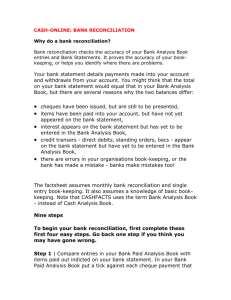
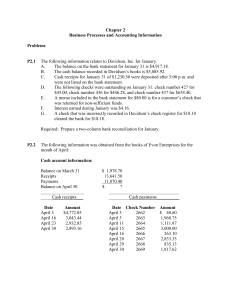
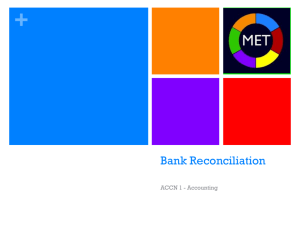

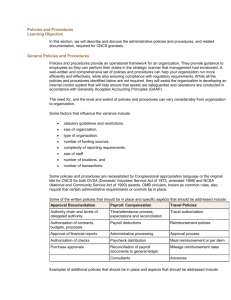
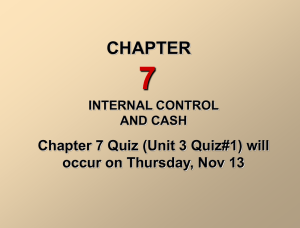
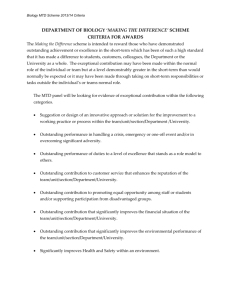
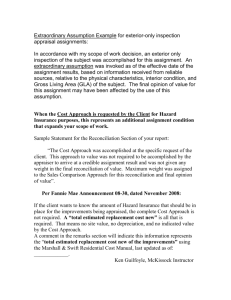
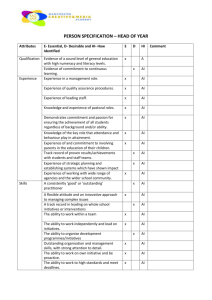
![[Sample] First Nation Cash Management and Banking Policy](http://s3.studylib.net/store/data/008537083_1-2984909933b7210a238ea8f483ded321-300x300.png)
